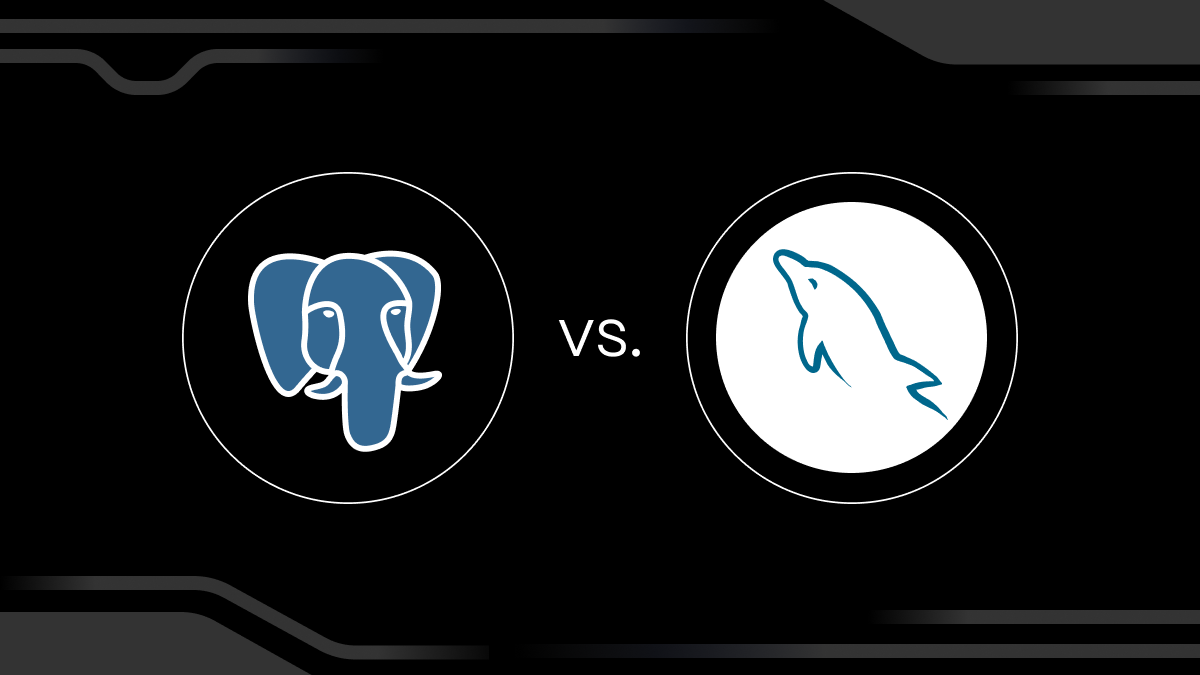PostgreSQL vs MySQL: Which to Choose and When

PostgreSQL kicked off the new year with a win: it was named the database management system of the year 2023 by DB-Engines. But what exactly makes it better? To answer this question, we'll compare PostgreSQL to MySQL, another widely used open-source relational database management system (RDBMS). As industry standard solutions, these databases share the power of SQL for managing relational data but have yet to diverge in their capabilities and optimal use cases.
This guide will explore the core similarities between PostgreSQL and MySQL as RDBMS built on SQL queries. We’ll then do an in-depth, side-by-side comparison based on factors like performance, flexibility, scale, and ease of use. We’ll determine the ideal conditions for choosing PostgreSQL or MySQL by evaluating their strengths and weaknesses across these criteria.
By the end, you’ll understand the best use cases, trade-offs, and limitations to select the right open-source RDBMS for your needs. You’ll gain perspective on when to leverage PostgreSQL’s advanced features versus when MySQL’s simplicity does the job.
First, before diving into their differences, let’s ground ourselves in what unites these databases as relational SQL platforms.
Relational Databases and SQL
PostgreSQL and MySQL, at their core, are relational database management systems built on the fundamental principles of relational databases. Relational databases store information in structured formats known as tables. Each table is a data collection organized into rows and columns, much like a spreadsheet.
The real power of relational databases lies in their ability to establish relationships between tables. This is done through keys—primary keys uniquely identifying a row in a table and foreign keys linking one table to another. These keys form the backbone of the “relational” aspect, allowing complex data structures and relationships to be efficiently represented and navigated.
Structured Query Language (SQL)
SQL, or Structured Query Language, is the standard syntax for interacting with relational databases. It allows for various operations like querying, updating, and managing data. At Timescale, we consider it the lingua franca for data analysis.
While each RDBMS may have its unique SQL flavor, the core syntax and commands are primarily consistent across platforms. This universal nature means that the skills and knowledge in SQL are transferable across different systems, including PostgreSQL and MySQL. PostgreSQL and MySQL utilize SQL as their primary interface for data interaction, ensuring you can leverage SQL's powerful querying and transaction capabilities.
Strengths and weaknesses of relational databases
Relational databases, particularly PostgreSQL and MySQL, are known for their user-friendliness. Their structured nature, combined with the intuitive SQL, makes them accessible and powerful tools for data manipulation. Features like stored procedures, relational normalization, and robust backup and replication tools further elevate their capabilities, ensuring data integrity and effective recovery options.
However, these systems have challenges. One notable limitation is their performance when scaling up to handle enormous datasets or complex queries (that is when Timescale will come to the rescue). The overhead associated with maintaining relational integrity can sometimes lead to slower performance at scale.
Different approaches to the same idea
While PostgreSQL and MySQL provide the power and reliability of a relational database, they approach their roles with distinct philosophies and feature sets. This divergence leads to different strengths suited for various use cases and scenarios. Next, we'll delve deeper into these specific approaches and what they mean for users like you.
Features of PostgreSQL and MySQL
PostgreSQL
PostgreSQL is a robust and versatile database management system (DBMS), often hailed for its advanced handling of complex data operations. As mentioned earlier, it was considered the 2023 DBMS of the year for the fourth time by DB-Engines.
This section will delve into PostgreSQL's object-relational model, its extensive data type support, and its adherence to ACID compliance, among other features.
MySQL
MySQL, in contrast, is known for its simplicity and efficiency. This section unpacks MySQL's approach as a more traditional relational database system. In comparison, it may not boast the same advanced features as PostgreSQL; MySQL shines in scenarios where simplicity, speed, and straightforward data management are crucial.
Which Database Solution Is Right for Me?
In assessing PostgreSQL and MySQL, we're not just comparing two database systems but exploring how each aligns with your specific project requirements, scale, and the nature of the data operations involved. This section of our discussion is pivotal, moving beyond the surface-level features to understand the practical implications of choosing one.
While PostgreSQL offers a rich set of functionalities ideal for complex and large-scale applications, MySQL's streamlined design caters well to more straightforward, static systems where efficiency and ease of use are essential. We aim to guide you through these nuances, helping you choose the best fit for your project's unique demands and scale.
Choosing PostgreSQL for your use case
PostgreSQL is renowned for its robust features. It offers advanced capabilities like various index types, custom data types, and support for different programming languages within the database. This extensive feature set makes PostgreSQL versatile and adaptable to complex data handling needs.
One of PostgreSQL's significant strengths is its strict adherence to ACID (Atomicity, Consistency, Isolation, Durability) principles. This compliance ensures that transactions are processed reliably, which is crucial for applications where data integrity and consistency are paramount. It’s essential for systems that handle critical operations, such as financial transactions or any scenario where data accuracy is a non-negotiable requirement.
PostgreSQL’s ability to interface directly with various programming languages (like Python, Perl, and C) within the database is a powerful feature. This allows for more complex and efficient processing of data and operations, providing a significant advantage in scenarios that require extensive data manipulation or custom business logic. This becomes increasingly relevant in light of the Matillion and IDG survey, which highlights the rapid growth of data volumes and the challenges businesses face in transforming this data for analytics.
Choosing MySQL for your use case
MySQL's more straightforward design translates to less complexity, making it an ideal choice for systems that are fully developed in-house. Its specific structure allows for easier understanding and maintenance, especially when the development team prefers a no-frills approach to database management.
MySQL is known for its efficient read operations. This makes it particularly well-suited for applications requiring data retrieval quickly and efficiently, such as in content delivery networks or basic data reporting systems.
Due to its simplicity and efficiency, MySQL is an excellent fit for simpler, static systems that don't require the extensive feature set of PostgreSQL. It's perfect for small-scale applications, websites, or any system where the database requirements are straightforward and don't involve complex data manipulation or multi-faceted transactional operations.
Here are a few in-depth examples to illustrate how PostgreSQL and MySQL cater to different scenarios, helping you decide which database suits your specific project or application needs.
Real-World Use Cases for PostgreSQL
- E-Commerce platforms: In the dynamic world of e-commerce, managing a vast inventory with complex product relationships is crucial. PostgreSQL excels with advanced features like custom data types and efficient write operations. These capabilities enhance data management and analytics, enabling e-commerce platforms to handle intricate product hierarchies, dynamic pricing models, and customer behavior analytics, ensuring a seamless and responsive shopping experience.
- Financial systems: PostgreSQL is a strong fit for financial systems where transactional integrity and complex calculations are non-negotiable. Its ACID compliance and robust indexing options support high-stakes banking operations, including real-time transaction processing, fraud detection, and risk management. These features ensure reliability and efficiency in handling sensitive financial data, maintaining accuracy in calculations, and supporting complex economic models.
- Data warehousing and analytics: PostgreSQL's ability to handle diverse data types and process complex queries is invaluable for organizations with large-scale data analysis. This makes it an ideal choice for data warehousing and analytics projects that require aggregating and analyzing vast datasets. PostgreSQL supports sophisticated data mining and predictive analytics, providing insights into customer behavior, market trends, and operational efficiency.
Real-World Use Cases for MySQL:
- Web applications and blogs: MySQL is a popular choice for web applications and blogs where quick data retrieval is vital. Its efficient read operations increase page load times, enhancing user experience. This is especially beneficial for content-driven sites, where speed and uptime are critical for maintaining user engagement and SEO rankings.
- Small-scale CRM systems: MySQL offers a straightforward and efficient solution for small-scale customer relationship management (CRM) systems. Its simplicity and reliability are ideal for managing customer data, tracking interactions, and supporting marketing initiatives without the complexity of more advanced database systems. This makes it suitable for small businesses or startups looking to manage their customer relationships with minimal technical overhead efficiently.
- Online forums and discussion boards: Online forums and discussion boards, which often require frequent read operations and have more superficial data structures, benefit from MySQL’s lightweight setup. It handles user-generated content, discussions, and user profiles effectively, providing a reliable and efficient platform for community engagement and sharing.
Deciding Factor: Scale and Complexity
The ultimate choice between PostgreSQL and MySQL often hinges on your project's specific scale and operational intricacy needs. If your project involves straightforward data handling or is of a smaller scale, the streamlined nature of MySQL can be a significant advantage.
However, for projects that demand the handling of voluminous or complex data, the comprehensive capabilities of PostgreSQL are likely more aligned with your requirements. This decision is fundamentally about matching the database's strengths to the demands and ambitions of your project—we may be biased here, but with its 30+ years of development, a wide range of PostgreSQL extensions, and incredible versatility, we believe that PostgreSQL is the only database you'll need.
Conclusion
In conclusion, PostgreSQL and MySQL excel in their respective environments, offering tailored strengths for different data management needs. While both are robust relational systems, handling massive databases can be challenging. This is where Timescale comes to the rescue, building up PostgreSQL's capabilities and boosting its performance, especially for time-series data, events, and analytics at scale.
Explore Timescale's capabilities and try it out today.





